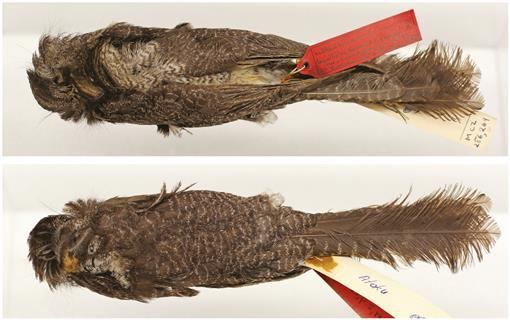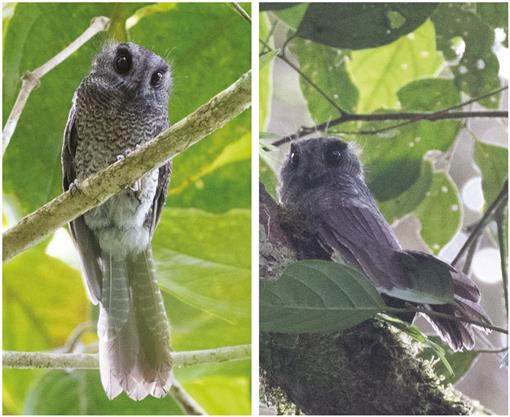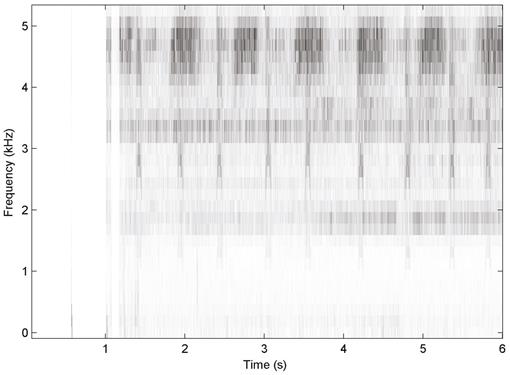First field observation of Karimui Owlet-Nightjar Aegotheles bennettii terborghi
Abstract
The owlet-nightjar Aegotheles bennettii terborghi
was described from a single male specimen given by a local man to Jared
Diamond, while he was collecting in the Karimui Basin in the Eastern
Highlands of Papua New Guinea, in 1964. There has been no further
observation of the taxon, despite extensive field work in 2011-12. In
July 2016 we travelled to Karimui with the explicit aim of searching for
this taxon, which resulted in the first-ever field observation,
including photographs and a possible sound-recording of its call.
Originally described as a subspecies of Barred Owlet-Nightjar Aegotheles bennettii terborghi, based on its similarity to the two mainland races—the nominate in southern New Guinea and wiedenfeldi in northern New Guinea—A. b. terborghi
differs mainly in its much larger size—male wing 154 mm vs. 114–128 mm,
and tail 142 mm vs. 99–110 mm in the other two subspecies of A. bennettii (del Hoyo et al. 2017).
It is also described as having much darker, blacker upperparts, with
the white speckling on the back and upperwingcoverts being somewhat more
distinctly organised into a regular transverse (barred) pattern (Diamond 1967, Holyoak 1999). However, there is considerable variation within the other subspecies of A. bennettii so any significant plumage differences require confirmation.
The holotype (MCZ 286269, see Acknowledgements; Fig. 1)
and only specimen was found by a local man, who stated that he had
found it roosting on a branch during the day and had caught it by hand (Diamond 1967). The exact location and altitude where the specimen was caught is unknown, but Karimui station is at c. 1,100 m. The other races of A. bennettii inhabit mainly lowland forest and the nominate subspecies is only rarely recorded to 800 m; A. b. plumifer on the D'Entrecasteaux archipelago is mainly found above 500 m (Beehler & Pratt 2016) and has been recorded to 1,100 m (Coates & Peckover 2001).
Dumbacher et al. (2003) published the first comprehensive molecular phylogeny of the Aegothelidae based on mitochondrial DNA. Their results reported A. b. terborghi to be most closely related to Allied Owlet-Nightjar A. affinis, a taxon known only from the Arfak Mountains of the Bird's Head Peninsula in West Papua. A. affinis was previously considered a race of A. bennettii,
but most current authorities treat it as a monotypic species endemic to
the Arfak Mountains; the notable exception being del Hoyo & Collar (2014), who included terborghi as a subspecies of affinis, following the results of Dumbacher et al. (2003). This classification yields an odd distribution pattern, with two disjunct populations separated by c. 1,400 km. However, Beehler & Pratt (2016) retained terborghi in A. bennettii, pending future studies, and noted that the possible species status of terborghi should be investigated.
Rediscovery
On
the morning of 18 July 2016 we flew into Karimui from Goroka, with the
Mission Aviation Fellowship. During the afternoon and evening we
explored the vicinity of Karimui village, where habitat consists mainly
of coffee plantations and small patches of secondary forest. The only
nightbirds identified were Papuan Boobook Ninox theomacha, Papuan Frogmouth Podargus papuensis and Marbled Frogmouth P. ocellatus.
The following morning we set off towards Mount Karimui, with the
intention of establishing a camp in the primary forest on the mountain's
lower slopes. Both previous expeditions to the area, by Diamond
(1964–65) and Freeman & Class Freeman (2011–12), conducted field
work along a transect on the north-west ridge of the mountain.
Figure 1.
The holotype (MCZ 286269) of Aegotheles bennettii terborghi in ventral and dorsal views (© Museum of Comparative Zoology, Harvard Univ., Cambridge, MA)

Diamond (1967) did not make any field observations of terborghi and in more than 12 weeks of field work Freeman & Class Freeman (2014) had no definite records, although they did hear an Aegotheles
sp. below 1,500 m which they did not identify to species. Vocalisations
heard at 1,420 and 1,910 m were attributed to Feline Owlet-Nightjar A. insignis, and an Aegotheles sp. heard at 2,520 m was presumed to be Mountain Owlet-Nightjar A. albertisi.
Our intention was to concentrate on searching for and identifying Aegotheles
along the same transect as previous expeditions. However, due to
alleged landowner issues, we instead worked the previously unexplored
north-east ridge of Mount Karimui. Negotiations with landowners were
handled by our local guide, Daniel Wakra. We were not permitted to
establish a camp inside the forest, but were instead allowed to stay in a
small hut at the edge of primary forest at c.1,380 m
(06°33.672′S, 144°49.436′E). The different landowner councils were
highly suspicious of our motives, and we were initially given permission
to remain just one night, but eventually negotiated to stay for two
nights.
Forest clearance for small-scale subsistence
farming and coffee plantations was rampant in the area, and only
smaller forest fragments remain below c.1,380 m; above this
elevation primary forest was more or less intact. During the first
afternoon we searched the trail following the ridge above our camp. We
were accompanied by five villagers, among them a hunter with bow and
arrow, who without prompting had pointed out both A. b. terborghi and A. insignis on the plates in our field guide (Pratt & Beehler 2015). At c.1,570
m he spotted an old tree with a nest hole and after pulling at a rattan
growing by the tree, a large, greyish owlet-nightjar flew from the hole
and landed above us (at 06°34.035′S, 144°49.177′E).
Figure 2A—B.
Karimui Owlet-Nightjar Aegotheles bennettii terborghi,
Mount Karimui, Papua New Guinea, July 2016, showing the darker, less
mottled upperparts, compared to other subspecies of Barred
Owlet-Nightjar A. bennettii (Markus Lagerqvist)

The bird flew after a few seconds, but was immediately identified as A. b. terborghi. Fortunately, it only flew a short distance and was swiftly relocated (Fig. 2A). We watched the bird for c.1
hour, during which time it moved between different perches in the area
and for a short period also entered a second tree hole. When the light
started to wane, we left the bird, still perched in the open. We all
possess previous field experience of Barred Owlet-Nightjar at Varirata
National Park (Central Province, Papua New Guinea), from which the most
striking differences to us were the bird's larger size and the less
patterned, more blackish, back of the A. b. terborghi (Fig. 2B).
It is also notable that the record is almost 400 m above the presumed
location of the only previous record, and much higher than other races
of A. bennettii. It is also just above the known upper altitudinal limit for A. affinis, which occurs at 80—1,500 m.
The following day was spent along the same ridge, following it to 2,050 m, where the trail ended. One Mountain Owlet-nightjar Aegotheles albertisi was seen in a tree hole at 1,980 m (06°34.750′S, 144°48.578′E). No further observations of A. b. terborghi were made. At dusk we positioned ourselves close to the tree hole from which the A. b. terborghi
had been initially disturbed on 18 July 2016, in an attempt to make
sound-recordings. As it became dark an owlet-nightjar-like call was
heard, and RN made a short sound-recording (Fig. 3)
of it before the intensifying sound of cicadas rendered further efforts
all but impossible. The call did not emanate from the roost tree, but c.15
m away at the forest edge. The bird could be heard vocalising as it
flew off into the distance, and there was no response to playback as it
was probably too far away. The recording will be made available at
Cornell's Macaulay Library archive; however as the vocalising bird was
not observed, definitive identification is impossible under present
knowledge.
Figure 3.
Sonogram of possible Karimui Owlet-Nightjar Aegotheles bennettii terborghi
vocalisation, recorded at Mount Karimui, Papua New Guinea, July 2016,
by Roger McNeill, using a Marantz PMD661 MKII recorder and Sennheiser
ME67 shotgun microphone; sonogram produced using Raven Lite v. 2.0.0.

Other nightbirds recorded around and above our campsite were Sooty Owl Tyto tenebricosa, Papuan Boobook, Marbled Frogmouth, Papuan Frogmouth and an unidentified owlet-nightjar.
The
next day, 20 July 2016, we had to leave the area in the morning as we
were not given permission to stay longer by the local landowners. On
reaching the first village en route to Karimui we were interrogated for
approximately one hour by the village magistrate and police, supported
by the villagers, who were still highly suspicious of our motives.
Initial demands for substantial financial compensation and seizure of
our photographs were eventually abandoned due to Daniel Wakra's ability
to explain the purpose of our visit. In the end all issues were settled
amicably, with the villagers stating that they would permit future
visits to the area, but nevertheless potential visitors should factor
flexibility and possible access issues into their plans. It is our hope
that the rediscovery of A. b. terborghi will encourage
further research into this enigmatic taxon, including its population
size, distribution and vocalisations, including qualitative comparisons
with A. b. bennettii and A. affinis.
Acknowledgements
We
thank Daniel Wakra for help with on-the-ground logistics, Thane Pratt
for his valuable comments on the submitted text, and the Museum of
Comparative Zoology, Harvard Univ., Cambridge, MA, for providing
photographs of the holotype of Aegotheles bennettii terborghi (MCZ 286269, collector no. 281).
References:
- Beehler, B. M. & Pratt, T. K. 2016. Birds of New Guinea: distribution, taxonomy, and systematics. Princeton Univ. Press. Google Scholar
- Coates, B. J. & Peckover, W. S. 2001. Birds of New Guinea and the Bismarck archipelago. Dove Publications, Alderley. Google Scholar
- Diamond, J. M. 1967. New subspecies and records of birds from the Karimui Basin, New Guinea. Amer. Mus. Novit. 2284: 1–17. Google Scholar
- Dumbacher, J. P., Pratt, T. K. & Fleischer, R. C. 2003. Phylogeny of the owlet-nightjars (Aves: Aegothelidae) based on mitochondrial DNA sequence. Mol. Phyl. & Evol. 29: 540–549. Google Scholar
- Freeman, B. & Class Freeman, A. M. 2014. The avifauna of Mt. Karimui, Chimbu Province, Papua New Guinea, including evidence for long-term population dynamics in undisturbed tropical forest. Bull. Brit. Orn .Cl. 134: 30–51. Google Scholar
- Holyoak, D. T. 1999. Family Aegothelidae (owlet-nightjars). Pp. 252–265 in del Hoyo, J., Elliott, A. & Sargatal, J. (eds.) Handbook of the birds of the world, vol. 5. Lynx Edicions, Barcelona. Google Scholar
- del Hoyo, J. & Collar, N. J. 2014. The HBW and BirdLife International illustrated checklist of the birds of the world, vol. 1. Lynx Edicions, Barcelona. Google Scholar
- del Hoyo, J., Collar, N. J. & Kirwan, G. M. 2017. Allied Owlet-nightjar (Aegotheles affinis). In del Hoyo, J., Elliott, A., Sargatal, J., Christie, D. A. & de Juana, E. (eds.) Handbook of the birds of the world Alive. Lynx Edicions, Barcelona (retrieved from www.hbw.com/node/467187 on 30 April 2017). Google Scholar
- Pratt, T. K. & Beehler, B. M. 2015. Birds of New Guinea. Second edn. Princeton Univ. Press. Google Scholar
© 2017 The Authors; Journal compilation © 2017 British Ornithologists' Club
Citation
Download Citation
Markus Lagerqvist, Markus Lagerqvist,
Ashley Banwell, Ashley Banwell,
Roger McNeill, Roger McNeill,
"First field observation of Karimui Owlet-Nightjar Aegotheles bennettii terborghi," Bulletin of the British Ornithologists’ Club 137(2), (18 June 2017). https://doi.org/10.25226/bboc.v137i2.2017.a7
Nenhum comentário:
Postar um comentário
Observação: somente um membro deste blog pode postar um comentário.